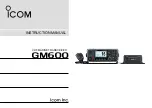
E2608-PID
Rev 05.03.2021
Properties of VOC: ionization energy, the correction factor
Sensors used in E2608-PID are calibrated using isobutylene, but the PID is a broadband
VOC detector, with a sensitivity that differs for each VOC. If you know what VOC you are
measuring, then the table below will allow you to calculate the concentration for your
specific VOC. Only the most common substances are listed in the table, if you can’t find
your compound of concern, please contact us.
NOTE! These are approximate values, so for the best accuracy, you should calibrate with
the relevant VOC.
The table includes the following columns:
1.
The most common name for the VOC or other substances,
2.
CAS No; You can find the VOC using the CAS No,
3.
Brutto-formula,
4.
Ionization energy (IE), (eV)
5.
Relative Response/ Correction Factor (CF), Also called the Response Factor (RF).
Multiply the displayed concentration by the Relative Response/CF/RF to calculate
the actual concentration of the VOC.
6.
Minimum Detection Level (MDL) Also called Minimum Detectable Quantity (MDQ).
The typical lowest concentration that can be detected. The sensor used in
E2608-PID-40 has greater sensitivity than that in E2608-PID-200, so the MDL for
the E2608-PID-40 will be much less than the MDL for the E2608-PID-200.
The Relative Response/CF/RF is measured in dry air; high humidity will reduce this factor
by 30% to 50%, so the CF/RF should be increased in high humidities. Relative sensitivity is
the inverse of the correction factor, specifying the percent response of the VOC, relative to
isobutylene. If less than 100%, then the VOC is less responsive than isobutylene; if the
relative sensitivity is greater than 100%, then the VOC is more responsive than isobutylene.
Relative sensitivity (%) is specified in the same way as cross-sensitivity for toxic gas
sensors.
VOC response
The PID can not measure all VOCs or gases, two types of VOCs are not measured:
NR: No response. The lamp does not ionize the VOC and the VOC cannot be measured.
NV: The vapor pressure of the VOC at 20°C is less than a few ppm, so this Semi-Volatile
Organic Compound (SVOC) cannot be measured.
NA: Not available
19
















































